First Timer at
Pine Barrens FUNctional Freestyle Canoeing Workshop,
Oct 18-20, 2019
YMCA of the Pines, Medford, New Jersey
By Keith Attenborough
Freestyle Canoeing is a particular style that is all about precise boat control through a combination of paddle strokes and body position. What caught my eye about this particular workshop was its focus on the practical application of these skills in day-to-day paddling. And boy, in the right conditions, do they ever apply. More on that later…
The Workshop was held at the YMCA of the Pines camp in Medford, New Jersey, in the area known as the Pine Barrens, a heavily forested area of coastal plains stretching across more than seven counties of New Jersey, laced with 28 separate named “rivers”. Quotes are because the “rivers” tend to be more narrow and (very) twisty than what I’m used to in Massachusetts (and which proved “interesting” on Sunday).
Following a few signs along the sand road through the grounds got me to Algonquin Village, the subsection of the camp reserved for the workshop. The Village is next to the lake, a five minute walk from the dining hall, and includes a heated bunkhouse with a common sitting and kitchen area, six small unheated cabins and space for tents.
The kick off afternoon intro session outlined how the workshop would be run. I was immediately impressed with three things: the carefully structured building block nature of the on-water instruction, the clear recognition that different folks click with different instructors, and the inclusion of “take it into the real world” paddle on the third day.
The first of the building blocks was laid Friday afternoon with a dedicated forward stroke session for all,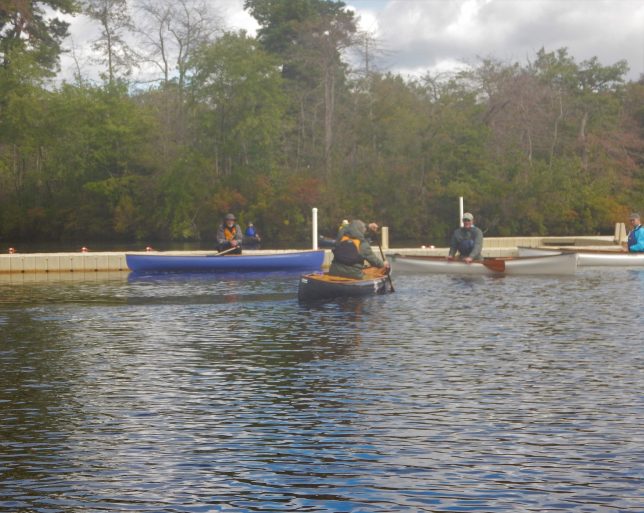 regardless of experience. The mantra of that session was “everything starts with going straight”, so we spent an hour plus focused on the keys to a solid forward stroke – loose grip, vertical shaft, short stroke, 90 degree feather and small correction move. Got a lot of hints on how to improve on each pass, and the mix of good humor, good instruction and nice weather kept it interesting.
regardless of experience. The mantra of that session was “everything starts with going straight”, so we spent an hour plus focused on the keys to a solid forward stroke – loose grip, vertical shaft, short stroke, 90 degree feather and small correction move. Got a lot of hints on how to improve on each pass, and the mix of good humor, good instruction and nice weather kept it interesting.
The second building block was an evening chalk talk that covered freestyle paddling principles, hints on reading the water, and specific terminology that would be used on Saturday. You’ve probably noticed that different specialties use their own language, so it’s good to pick up the local jargon. For example, the essentials of a Freestyle “axle” – an on-side turn around a “planted” paddle. A similar move is described in Bill Mason’s “Path of the Paddle” as a “running bow cut” and in Greg and Joanie McGuffin’s “Paddle Your Own Canoe” as a “Duffek”. For me, being able to cross-connect the term to something familiar made learning the subtle differences in the FreeStyle maneuver easier.
The Saturday morning session continued to add building blocks with three 40 minute sessions covering a total of 10 different strokes and/or maneuvers. Many of these were familiar to me (sometimes under different names), but the intense focus on refining them to achieve very precise boat control was different. The importance of a second basic principle, not switching hands when switching sides, also became apparent as we moved through the various onside and offside versions of key moves, like axle and cross axle, forward and cross forward. Again – done with good humor, ensuring it was fun and not intimidating.
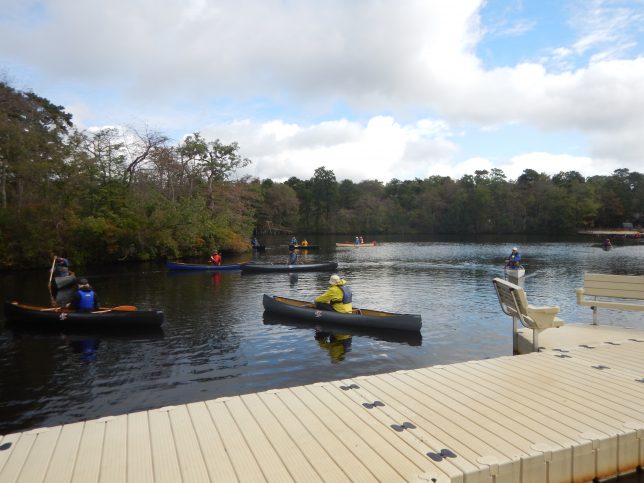 The instructors rotated between each class of students after each of the three sessions. As a student this was great because I got to hear a different view of something I was trying and sometimes it just took a different voice and a different phrase to suddenly make a key concept click.
The instructors rotated between each class of students after each of the three sessions. As a student this was great because I got to hear a different view of something I was trying and sometimes it just took a different voice and a different phrase to suddenly make a key concept click.
The afternoon started with instructors demonstrating ways in which the strokes and maneuvers might 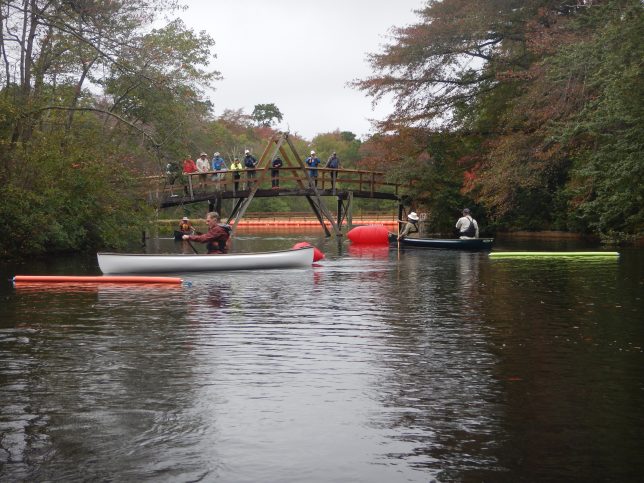 be used with an obstacle course of various floats and pool noodles meant to simulate rocks and downed trees. Afterwards all of us got a chance to run the course and see that our slide slip really did let us move to the side of the “branch” or that the axle really did spin us around the “rock” in time to avoid a bow crunch.
be used with an obstacle course of various floats and pool noodles meant to simulate rocks and downed trees. Afterwards all of us got a chance to run the course and see that our slide slip really did let us move to the side of the “branch” or that the axle really did spin us around the “rock” in time to avoid a bow crunch.
The final Saturday session, Fine Tuning, was the most informal part of the program. The instructors simply spread out on the lake and we hunted up the ones we had clicked with in the morning to work on the stroke(s) causing us the most problems. For me it was the cross forward stroke, a short, powerful stoke on the offside, done without changing your paddle grip. “Otter”, an instructor from Canada, convinced me that “short” meant “really, really short” – like 12 to 16 inches short. Who knew? (Otter did).
The result of all of this was that by the end of Saturday we newbies had a solid grounding in the basic techniques and a good idea of how to adjust them to our particular boats. The more experienced folks had also benefited by getting additional polish on their strokes from the wide variety of instructors.
All of which was the set up for Sunday’s “practical application” exercise on the Mullica River.
Here was the opportunity to move from theory on the lake’s quiet water to reality on the river’s moving water. And the Mullica, with its current and twists, turns, beaver dams, shallows, blowdowns and submerged logs became a real world playground to practice what had been preached.
We broke into two groups – one paddling down river and the other up and down, doing an “ascent” then returning to the launch point. I talked my way into being the fourth student paddler in the up and down group. Rain was in the forecast, so we geared to get wet. We got launched, started up river and the real stuff (and the rain) began…some examples…
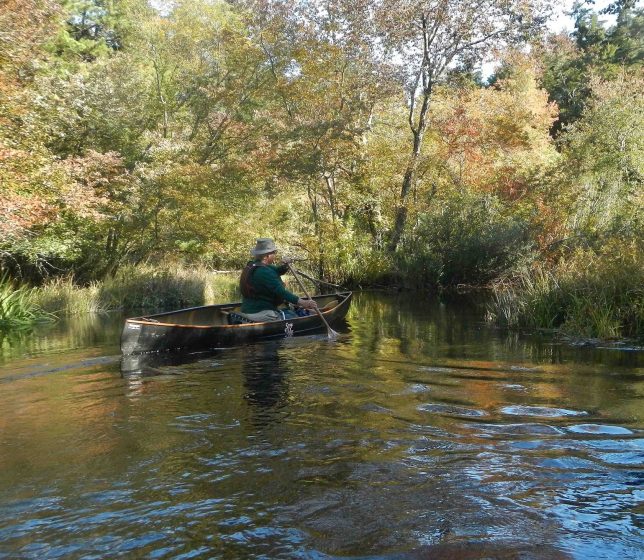 Paddling the current: Current tends to follow the outside of corners. But in the Barrens you get curves where the current shifts from river left to river right in about 50 feet, so whaddya do? Use that finely tuned “go straight” forward stroke from Friday afternoon’s session to smoothly move along a straighter line across the curves rather than following the bends.
Paddling the current: Current tends to follow the outside of corners. But in the Barrens you get curves where the current shifts from river left to river right in about 50 feet, so whaddya do? Use that finely tuned “go straight” forward stroke from Friday afternoon’s session to smoothly move along a straighter line across the curves rather than following the bends.
90 degree turn against the current:  You’re in a 14 foot canoe in a 12 foot wide river, facing a 90 degree corner and a downstream current stretching from the middle to the far bank. You need to get around without sticking the bow into current. Time to remember Saturday’s lesson on the Axle/X-Axle. Initiate with a strong J/sweep, plant the paddle and ride the turn, conclude with a bow/cross bow draw and a solid forward/cross forward to regain speed.
You’re in a 14 foot canoe in a 12 foot wide river, facing a 90 degree corner and a downstream current stretching from the middle to the far bank. You need to get around without sticking the bow into current. Time to remember Saturday’s lesson on the Axle/X-Axle. Initiate with a strong J/sweep, plant the paddle and ride the turn, conclude with a bow/cross bow draw and a solid forward/cross forward to regain speed.
Keeping the paddle: The Mullica is colored by tannins, so it’s difficult to see what may be under the water. You have no idea when you put your paddle in what it’s going to hit – deep water, sand 3 inches down, a log or tangle. Use a tight grip and the least you get is a good shock to the shoulder. Worse is losing the paddle or even coming out of the boat. That loose grip from Friday’s forward stroke clinic will save you.
And so on – it seemed every twist and turn, log and occasional beaver dam was precisely planned to illustrate and reinforce how the techniques from Friday and Saturday applied to everyday paddling. A great finish to a very FUNctional Freestyle workshop.

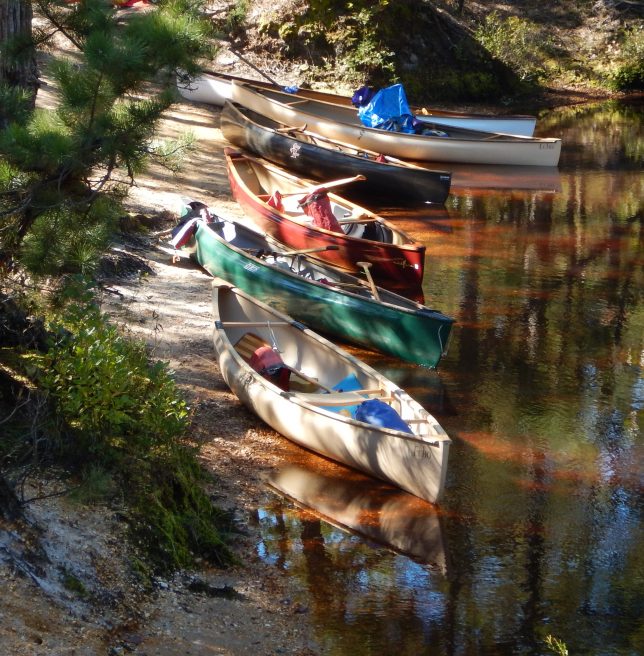
Quick summary – I learned a lot, met good people, had fun on the water, and went away with an additional set of tools to apply to my daily paddling. I want to thank the organizers – Tim, Marc, and Bruce – the instructors, and fellow attendees for a great event and recommend it to paddlers at all skill levels.